quarterbacks
rawr.
This is the second installment of a comprehensive look at quarterbacks whom Jim Harbaugh recruited and coached. Part 1 looked at his WKU recruits, his work with the Oakland Raiders, and his first head coaching job at San Diego. A few trends that came out:
- He recruits at least two QBs per class
- They tend to look like shooting guards: tall, athletic, gangly, on the border of dual-threat/pro-style. He scouts them at multiple sports.
- Their teams usually perform above or far above the usual for that program.
- He likes them smart.
We are now entering the Stanford phase, so it’s a good thing we could notice item #4 above before the sample was ruined.
We also got an idea of how Harbaugh coaches them. He likes his heady guys to memorize a million things they can think about pre-snap. When he has one of those guys, they go to the line with three plays called, and the quarterback decides which by defensive alignment. Conversely, post-snap reads are super-simplified and drilled mercilessly so that his QB barely has to think about his progressions during a play.
This week we get into his last two stops before Michigan.
----------------------------
Stanford
Head coach and quarterbacks coach, 2007-'10
2007: Harbaugh took over at Stanford in December 2006 with Kellen Kiilsguaard, a high three-star dual-threat, and L.D. Crow, an early-recruited academic from the South, already committed. Crow was on a lot of 2007 early watch lists (I know because I was reading those religiously for Mallett news) and Stanford's first commit of that class, but he was passed by a lot of guys by Signing Day (not Nick Foles, Kellen Moore, or Ryan Lindley). Kiilsguaard would eventually switch to safety. Harbaugh couldn't lure another QB but did get a transfer from Michigan. MGoBlog's Brian Cook:
Redshirt sophomore quarterback Jason Forcier can read the writing on the wall -- it says "Jesus Christ, that kid can throw eighty yards" -- and is transferring to Stanford effective at the end of the semester. Lloyd is not happy about it.
Forcier, like all Forciers, was an accurate Marinovich project with enough legs to be classified as a dual-threat but not enough to overshadow his passing.
On the roster were a pair of fliers in Alex Loukas, a 6'4/193 Purdue-al-threat (see: every other Purdue quarterback of the period), and Marcus Rance, a barely three-star guy from Washington whose next best offer was Idaho. Harbaugh also inherited a 5th year senior and on-and-off starter in T.C. Ostrander, an Elite 11 prospect who signed as a 4-star and two spots below Brady Quinn in a deep year for pro-style QBs. Ostrander split time with 2006 3rd round draft pick (and former 5-star) Trent Edwards for three seasons.
| T.C. Ostrander | Passing | Rushing | Total | ||||||
|---|---|---|---|---|---|---|---|---|---|
| Year | Att | Cmp% | TD | Int | Yds | Eff | Att | Yds | YPP |
| 2004-'06 | 351 | 48% | 8 | 8 | 2361 | 107.04 | 96 | -340 | 4.52 |
| 2007 (Harbaugh) | 229 | 57% | 7 | 3 | 1422 | 116.40 | 32 | -171 | 4.79 |
Last among inherited bullets was Tavita Pritchard, a 2005 3-star pro-style guy ranked just behind Colt McCoy. Pritchard had thrown one pass—that incomplete—and was sacked on three other career snaps before Harbaugh arrived.
Ostrander suffered a seizure the week Stanford would go into #1 USC as 41-point underdogs. Against a brutal defense, Pritchard wasn't doing too hot—he'd go 11/30 for 149 yards, 1 TD and 1 INT in that game. But then 20 of those yards were a laser to Richard Sherman, and another 10 were the fade to Mark Bradford to win it. Pete Carroll wanted to know what Harbaugh's deal was.
Harbaugh's deal was he was recruiting quarterbacks. Andrew Luck committed at the end of June 2007, before Stanford had played a game under Harbaugh. The interest in Stanford was already there for the academic Texan, and meeting Jim sealed it.
Jim continued to recruit a second QB for the class. Targets included Dayne Crist (Notre Dame), Jerome Tiller (ISU), Sean Renfree (Duke), Ted Stachitas (Wake Forest), Wayne Warren (Rutgers), B.R. Holbrook (New Mexico), and another Texas prospect, Robert Griffin III. RGIII turned down Harbaugh's offer because of Stanford's admissions policy:
“I was graduating early, and Stanford wasn’t allowing early graduates to enroll and that was the biggest issue,” Griffin said.
So Stanford wound up with just one quarterback for the class. Luck was the epitome of the Harbaugh quarterback recruit: valedictorian smart, extremely productive in high school, cool demeanor, and some wiggle. Under Harabaugh he would develop into the best pro prospect since Peyton Manning, whom Luck displaced.
| Stanford Quarterbacks | Passing | Rushing | Averages | ||||||||
|---|---|---|---|---|---|---|---|---|---|---|---|
| Year | W-L | Player | Att | Cmp% | Yds | Rtg | Att | Yds | YPP | TD Rate | Int Rt |
| 2006 | 1-11 | Trent Edwards | 156 | 60.3 | 1027 | 120.6 | 59 | 37 | 4.95 | 2.8% | 2.8% |
| T.C. Ostrander | 158 | 45.6 | 918 | 94.3 | 39 | -153 | 3.88 | 1.5% | 2.5% | ||
| 2007 | 4-8 | T.C. Ostrander | 229 | 56.8 | 1422 | 116.4 | 32 | -171 | 4.79 | 2.7% | 1.1% |
| Tavita Pritchard | 194 | 50.0 | 1114 | 97.5 | 66 | 45 | 4.46 | 1.9% | 3.5% | ||
| 2008 | 5-7 | Tavita Pritchard | 254 | 57.9 | 1633 | 114.6 | 66 | 113 | 5.46 | 3.4% | 4.1% |
| 2009 | 8-5 | Andrew Luck | 288 | 56.3 | 2575 | 143.5 | 61 | 354 | 8.39 | 4.3% | 1.1% |
| 2010 | 12-1 | Andrew Luck | 372 | 70.7 | 3338 | 170.2 | 55 | 453 | 8.88 | 8.2% | 1.9% |
| 2011 | 11-2 | Andrew Luck | 404 | 71.3 | 3517 | 169.7 | 47 | 150 | 8.13 | 8.6% | 2.2% |
| 2012 | 12-2 | Josh Nunes | 235 | 52.8 | 1643 | 119.6 | 27 | 74 | 6.55 | 5.0% | 2.7% |
| Kevin Hogan | 152 | 71.7 | 1096 | 147.9 | 55 | 263 | 6.57 | 5.3% | 1.4% | ||
TD rate and INT rate on the right are percentages for all attempts (passing and rushing
The sophomore Luck won the job over the incumbent senior Pritchard in 2009, but it was his junior season, 2010, when he really became Andrew Luck.
[Jump for 2009-2010 targets and the San Francisco story]
Michigan's offense this year is facing the mother of all X factors in its quarterback situation. Brady Hoke left the rest of the team in relatively great shape, but its most important position in a Shane-or-die position.
Hoke and his staff recruited just Russell Bellomy (a last-minute flier stolen from Purdue) in the hybrid 2011 class, and skipped a quarterback altogether in 2012 because they already had a commitment from Morris in 2013. This was a bad idea then, and worked out awfully for Michigan. Bellomy's injury ruined any chance of a badly needed redshirt for Shane, so even if Morris worked out he'd be gone after 2016. And if he didn't work out: Michigan was going into this year hoping to catch lightning in a freshman from either lone 2014 recruit Wilton Speight, or early enrollee Alex Malzone.
From left: Morris, Speight, Malzone, Gentry, O'Korn. O'Korn won't be eligible in 2015 due to transfer rules but gives Michigan a guy they didn't have between Morris Speight.
This won't happen under Harbaugh. The former Michigan and NFL star likes lots of bullets and lots of competition at his old position, which he personally coaches. Harbaugh has already added the high-ceilinged Zach Gentry, a perfect complement to the high-floor Malzone. By this time next year (unless there's attrition), Michigan should have the above plus two years of eligibility remaining on Houston transfer John O'Korn, and likely one or two of the nation's best freshmen.
What I'd like to do, then, is go back through Harbaugh's quarterbacks—the starters and the recruits—to see if we can find any common threads in the type of guy he adds to the pile, and the type of guy who emerges from it.
----------------------------
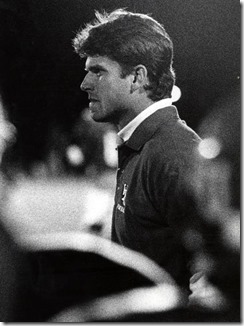 |
| Jim used his Orlando offseason home as a base from which to recruit the talent-rich region for WKU. [USA Today] |
Western Kentucky
Recruiting assistant, 1994-2001
Bo's former defensive backs coach Jack Harbaugh was coaching at Western Kentucky, and struggling through his first few years, when the school decided it would cut two assistant coaching positions and a handful of scholarships (they already put very little toward equipment). His sons offered to do some scouting and recruiting for him—John from Cincinnati and Jim from his house in Orlando—and the harvest from those recruits was an WKU's rise to a I-AA national championship in 2002 and eventual reclassification into Division I-A.
The Jim-John co-op (John was doing much of the scouting, passing on guys Indiana couldn't recruit) was personally credited with 17 players on the national championship team. Nick Baumgardner got the story of Jim's first quarterback recruit, Willie Taggart:
Harbaugh explained he was trying to round up some talent for his dad's program. He told Taggart that he and his father were watching tape of Manatee and asked, "Who is that little skinny guy?" Jim said he thought he should play quarterback in college and he'd come by the school on Tuesday at lunch to discuss it further.
Taggart hung up and assumed it was a prank or something. "I called my high school coach and he checked on it and said, 'Yeah, Jim is Jack Harbaugh's son.'
Manatee was a Tampa area powerhouse back then, so Taggart's a guy who absolutely would have shown up on recruiting radars today, and had FBS programs looking at him then. He became the best QB in school history, improving a 2-8 team in in 1995 to 7-4 in '96 and 10-2 in '97. Taggart is now USF's head coach, and was an assistant for Jim at Stanford.
Taggart returned to WKU in 2000 and ran an option offense that rotated between three candidates. The original winner was Jason Johnson. They got the 6'3/200 Johnson out of Palmetto, but with the limited scholarships they couldn't offer him one out of high school. Johnson went to a military college for a few years before being re-recruited:
It was during that second season that Johnson had to renter the recruiting game. He was in contact with a number of Division programs, including Clemson, South Carolina, Kansas State and Indiana, but in the end Western won out.
Donte Pimpleton was the second, a local-ish dual-threat kid who wound up playing receiver—there isn't anything on the internet connecting his recruitment to the brothers. The third candidate, and the starter of the 2002 championship team, was Jason Michael, another local recruit, onetime Jim Harbaugh assistant in SF and now the OC of the Tennessee Titans,
Jim did recruit Alan Ogletree, an overlooked athlete from Atlanta who ended up starting at every position in the defensive and offensive backfield for the Hilltoppers (QB, RB, FB, WR, CB, SS, FS, K, P).
[After the jump: Raiders and San Diego]
Camps are forming around Malzone: is he a program savior who just happened to be born in the right state rooting for the right team, or is he a Plan B kind of guy you'd expect to go to State in a heretofore "normal" year? Where would you put him on the Cone-Henson Scale?
Explanation of the Cone-Henson Scale of Quarterback Recruit Excitement Level:
Cone is the guy you get when Henne just completed his freshman season, and you only hope to see in freestyle rap videos or junk time against Delaware State; Henson was the late-'90s equivalent of top overall player in the country. He who cannot be charted not charted--went back to '98 so it won't be the "Cone-Mallett" scale. I have them ranked worst to first within the categories, which are:
- Need the Dudes: David Cone ('05), Justin Feagin ('08), Jermaine Gonzalez ('00), Spencer Brinton ('01transfer), Russell Bellomy ('11), Jason Forcier ('06)
- Seems Like Our Kind of Guy: Steve Threet ('07 transfer), Wilton Speight ('13), Tate Forcier ('09), Clayton Richard ('03), Andy Mignery ('99), Matt Gutierrez ('02), John Navarre ('99), Shane Morris ('13)
- Hey-O!: Devin Gardner ('10), Chad Henne ('04), Ryan Mallett ('07), Drew Henson ('98)
---------------------------
Ace: I'd say Malzone fits snugly into the middle category. I expect that by the end of the recruiting cycle, if not sooner, he'll be a four-star or close to it on all of the recruiting services—Scout already has him there, the Rivals guys are hinting he'll get the bump when the non-Rivals250 four-stars are released Wednesday, and ESPN left him entirely unranked despite a glowing evaluation. 247 at least ranks Malzone, but has him behind a few players with very limited offers—the pro-style QB three spots in front of him on their position rankings holds this offer sheet: Arkansas State, Charleston Southern, Georgia State, Marshall, Middle Tennessee State. I think Malzone's gonna jump that guy.
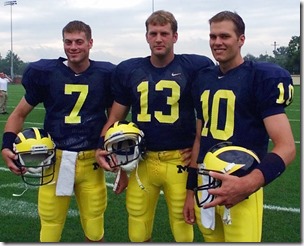 |
| In '96, Jason Kapsner was a recruit on par with Mallett. Michigan didn't take a QB in '97 but people figured with Kaps, Dreisbach and Brady on the roster, Henson might have to wait until 2001 for the roster to clear out. [SI] |
Also supporting Malzone as an "our kind of guy" recruit is the timing of his commitment; if Michigan didn't feel he was capable of being a quality college starter, they wouldn't have offered him eight months before Signing Day in a class with room for just one quarterback. Also, Malzone seemed like a prospect who would've committed to Michigan regardless of when they offered—being a Wolverine was clearly a lifelong dream of his—and U-M evaluated plenty of highly ranked QB prospects; there was no reason to offer when they did if they didn't believe he'd be able to supplant Morris (or Speight) when the time comes.
Finally, there's his film, various camp evaluations, and recent offers; all point to Malzone as an accurate passer with solid arm strength and the intelligence to quickly absorb and take command of a playbook. The area most cited for improvement last fall, Malzone's baseball-influenced mechanics, had become a source of praise by this spring's camp season. His height (6'2") and lack of a Henne/Mallett/Morris-level cannon will probably keep him from being an NFL prospect; that doesn't so much matter at the college level, however, and I see no reason he can't succeed as a starter at Michigan.
[jump]
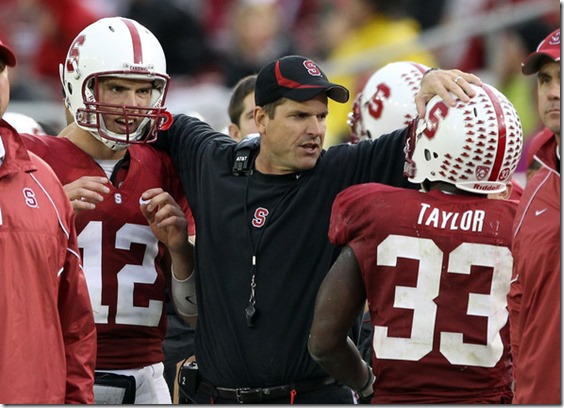
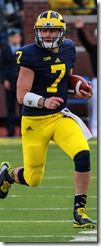

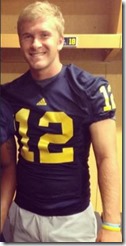


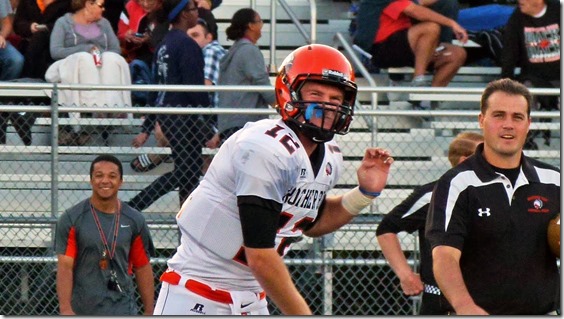
35